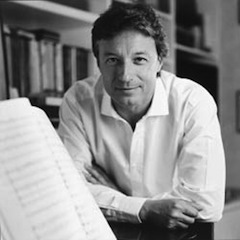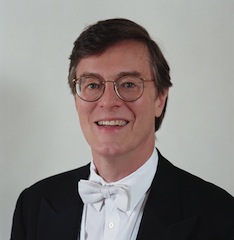
Abbado, Serkin Shine with the CSO

Abbado, Serkin. Some famous names dropped by the Cincinnati Symphony
Orchestra Friday morning at Music Hall.

Guest conductor Roberto Abbado, nephew of famed conductor Claudio Abbado, made a sterling debut with the orchestra (one wondered why it has taken so long). Guest artist, pianist Peter Serkin, son of the great pianist Rudolph Serkin, has performed with the CSO on previous occasions, but it is always a treat to have him back.
The program spanned romantic to 20th-century modernist music, with Mussorgsky’s “Pictures at an Exhibition” in the orchestration by Ravel, Suite No. 2 from the ballet “Bacchus et Ariane” by Albert Roussel (1930) and two pieces by Igor Stravinsky at opposite poles of his stylistic output, the 1929 neo-classic Capriccio for Piano and Orchestra and Movements for Piano and Orchestra, dating from the composer’s late 12-tone period (1958-59).
There were students from several area schools in attendance who got a good exposure to classical music in some of its varying guises.
Abbado, 56, former chief conductor of the Munich Radio Orchestra, is currently artistic partner of the St. Paul Chamber Orchestra (a shared music directorship). He is also a renowned opera conductor. From the opening bars of “Bacchus et Ariane,” it was clear that there was a master on the podium. His beat is clear and precise, whether conducting with or without a baton (he alternated during the evening). It was also clear that he and the musicians were on the same wavelength, so keenly did they respond to his direction.
“Bacchus et Ariane” tells the story of Ariadne, daughter of King Minos of Crete, who is abandoned on the island of Naxos after helping Greek hero Theseus kill the Minotaur (resident beast on Crete) and escape the Labyrinth. The Suite No. 2 begins with Ariadne asleep on a rock (where the god Bacchus has put her after dismissing Theseus). She awakens, to be romanced by Bacchus, then joins him in his bacchanals and becomes his wife.
Abbado’s rapport with the orchestra was evident from the first bars of the Suite, where he coaxed an ineffably soft, suede sound from the strings as Ariadne lay sleeping. This created just the right atmosphere for principal violist Christian Colberg’s affecting solo.
Abbado’s attention to detail brought the story wonderfully to life: the god’s furtive arrival to swoop up the despondent damsel, the warmth of their kiss (strings and horns with a touch of cymbal) and the concluding full orchestra revelry. One hardly needed a synopsis to “get it.” Compliments to the CSO winds for their nimble playing during the lovers’ dance.
Twelve-tone or not, Stravinsky still manages to sound like Stravinsky, as his Movements for Piano and Orchestra attests. Sparely but colorfully orchestrated, it was a challenge to bring off, but Serkin and the CSO gave it a fine reading under Abbado, whose quick and very precise cueing gave it the flow and cohesion it needed.
Stravinsky’s “Capriccio for Piano and Orchestra” is a horse of a different color. In three movements, it brims with wit and charm. Joining Serkin was a quartet of CSO soloists, concertmaster Timothy Lees, violist Colberg, principal cellist Ilya Finkelshteyn and principal bassist Owen Lee. The Presto first movement turned the tables on the audience when a jaunty little tune (Serkin interacting rhythmically with the CSO) broke out after an oh-so-serious beginning. The Andante rapsodico featured a dramatic cadenza by Serkin, while the concluding Allegro capriccioso let everyone in on the fun. It was music to make you smile (as Abbado did, acknowledging all the players afterward).
One of the true aristocrats of the piano, Serkin, brought commitment and style to Stravinsky’s demanding scores. Both works were heard in their CSO subscription premieres, a testament to Serkin’s special gifts as well as his thoroughgoing musical integrity.
Mussorgsky-Ravel’s “Pictures” is one of the all-time audience pleasers, but this was no ordinary pot-boiler reading. Details emerged with renewed clarity and nuance, as in the slight lengthening and emphasis on the string entrance in the opening “Promenade.” For his (very considerable) part, principal trumpet Robert Sullivan soared on the “Promenade” theme.
Abbado put his baton down in “Il Vecchio Castello” (“The Old Castle”) where saxophonist James Bunte projected its melancholy song sweetly, veiled by muted strings. Tubist Carson McTeer had a fine solo turn in “Bydlo” over trudging cellos and basses, and one could hear every last low note of the harp.
“The Ballet of the Unhatched Chicks” gave the oboes a chance to shine (tweet) and Sullivan made the trumpet solo in “Samuel Goldenberg and Schmuyle” sound easy (what a gorgeous sound after his crisp staccato passages).
Abbado led a perfect, pinpoint plunge into “Catacombs” after the frantic “Limoges” (a bustling French market). All shades of darkness could be heard here, followed by a very spooky “Cum Mortuis in Lingua Mortua” (“With the Dead in a Dead Language”). “The Little Hut on Chicken’s Legs” (home of the witch Baba Yaga) came smashing out of the silence, and there was a perfect, smooth, crescendo transition to “The Great Gate of Kiev.” Abbado led without a baton here, too, with hand and body language to convey the grandeur of the scene.
Audience response was long and loud. Abbado deigned to take a solo bow, but had the musicians, individually, and as a body, stand and receive the accolade.
The concert – a choice one – repeats at 8 p.m. Saturday and 3 p.m. Sunday (April 9 and 10). The Sunday concert, which has no intermission, will include the Stravinsky “Capriccio” and “Pictures at an Exhibition” only. Tickets begin at $10. Call (513) 381-3300, or order online at www.cincinnatisymphony.org